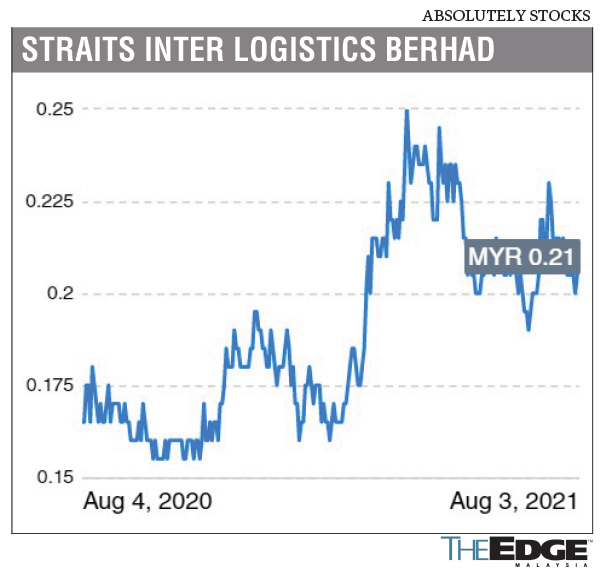
This article first appeared in The Edge Malaysia Weekly on August 9, 2021 - August 15, 2021
THE development of an offshore ship-to-ship (STS) energy transshipment hub in Victoria Bay, Labuan, is envisaged as a game changer for oil trading and fuel bunkering service provider Straits Inter Logistics Bhd.
“The project is huge. We are creating one of the largest offshore STS liquefied natural gas (LNG) and liquefied petroleum gas (LPG) transshipment hubs in Asia. Its contribution [to revenue] will be quite significant,” Straits group managing director Datuk Seri Ron Ho Kam Choy tells The Edge in an interview.
The project is estimated to bring in an additional US$12.95 million (RM54.6 million) in yearly revenue to the group, based on the projection that each STS transfer is expected to generate US$185,000 in revenue and that it would carry out at least 70 STS operations a year. STS enables the transfer of cargo between two seagoing ships moored alongside each other without having to dock at piers.
Total revenue for Straits in the financial year ended Dec 31, 2020 (FY2020), was RM675.32 million — a 1.8% increase from the previous year — and Ho expects the project to be accretive to the group’s total revenue from FY2022.
Last month, Straits announced that it had received approval from the Marine Department, a federal agency under the Ministry of Transport, for Victoria STS (Labuan) Sdn Bhd to develop the STS hub in waters within the vicinity of Labuan Liberty Port. Victoria STS is a 70%-owned subsidiary of Fajar Maritime and Logistics Sdn Bhd, which in turn is 60% held by Straits and 40% by Danau Murni Sdn Bhd. Datuk Seri Tiong Chiong Kui holds the remaining shares in Victoria STS. Companies Commission of Malaysia data shows that shareholders of Danau Murni are Yap Poh Onn and Kuek Sim Yee.
The project fits perfectly into the local ecosystem, benefitting from the existing infrastructure at Labuan Liberty Port, which is operated by Straits’ 51%-owned subsidiary Megah Port Management Sdn Bhd (MPM) under a six-year concession that expires in April 2026. Its 70%-owned subsidiary Tumpuan Megah Development Sdn Bhd (TMD) gives Straits another edge over its competitors as it could provide oil bunkering services to vessels that use the STS facility. “We will be able to provide customers with a one-stop service,” says Ho.
Still, several STS locations already exist in Malaysia such as Linggi, Kukup and Johor. KA Petra Sdn Bhd and Hutchison Port Holdings Ltd, controlled by Hong Kong tycoon Li Ka-shing, are also reportedly investing up to US$180 million to set up the world’s biggest STS hub in Johor waters, which is due to be completed by the end of this year.
Because of this, the STS facility in Victoria Bay will try to differentiate itself from rivals in the country with its focus on LNG and LPG cargo transfer. Subic Bay in the Philippines is its closest rival in this space, but Ho points out that it only has one approved LNG STS berth while Straits’ STS hub will have six berths.
Ho says the STS hub marks a milestone for the group, which has been looking to expand beyond fuel bunkering into the clean alternative energy industry. The group has diversified its business to include port operation, vessel management and transport services.
“When MPM was awarded a contract to operate Labuan Liberty Port last year, we were looking around to see if we could broaden and enhance our service offerings to create value for our shareholders. With the onset of this STS project, it is actually a realisation of our vision, which is to move into offering clean energy solutions to support the decarbonisation of the maritime, transport and energy industries,” he says, adding that Straits recently obtained its shareholders’ nod to change its name to Straits Energy Resources Bhd.
The STS hub encompasses 3,309ha of water area, with depths of between 27m and 30m, and will be able to accommodate up to six berths. The facility will also be able to handle vessels of 345m in overall length and very large crude carriers of 300,000 tonnes.
Allocating RM15m for STS hub capex
Interestingly, Straits is allocating a mere US$3.65 million (RM15.3 million) for Phase 1 of the project, which includes the purchase of pneumatic fenders, single point mooring (SPM) systems, consumables and spares, vessel traffic system and investment in its operation site office as well as Victoria STS’ headquarters.
Ho says the budget allocation is based on the assumption that the group carries out 70 STS transfers per year — and that is a conservative estimate by Straits’ count. It expects to complete the development of the STS hub and commence operations by the fourth quarter of this year. “The initial round of funding will be from internal funds. But as the project takes off to the next level, where we look into growing the number of berths from six to 12, we may seek borrowings from banks.”
At the end of March, Straits had cash of RM28.51 million and total debt of RM81.14 million. Its net gearing stood at 0.41 times.
Ho is comfortable with the current level of gearing. The group had completed a private placement in March, raising RM20.43 million.
Owing to Straits’ committed capital expenditure at US$3.65 million, which is nowhere near KA Petra-Hutchison’s US$180 million level, comparisons have been drawn. Ho notes that the STS operation in Victoria Bay has been carefully planned to coexist with the existing marine environment, avoiding any dredging or building of permanent fixtures which could disrupt the ecology in the area.
“The initial phase is to provide a hybrid of open anchorage berths and SPM weathervaning systems, which would support up to six STS berths with a safe operating diameter of between 1,600m and 2,400m, depending on specific user vessel requirements. But subject to market demand and capacity utilisation, the spatial design allows for commissioning of modular mooring infrastructure and technology that would allow the operating radius to be reduced and potentially doubling up the number of berths to up to 12,” Ho explains. “Also, Straits has entered into an agreement with Norway-based ECONNECT Energy to deploy new technology for STS berthing, which can even scale the number of berths to up to 18 without any impact on the marine environment.”
He expects the six-berth capacity to be sufficient for the next five years. “We don’t really see the need to have more than 12 STS berths based on the current small-scale LNG distribution, ecosystem and breakbulk business [in this area].”
Ho says Victoria STS has received numerous enquiries from both international and local oil majors to jointly develop the STS hub. “We have signed a memorandum of understanding with MISC Maritime Services Sdn Bhd to see how we can work together as strategic partners in the development of the hub. Ultimately, we want Victoria STS to be a Malaysian brand. We want to project to the world that we are capable of handling business of this size,” he adds.
“The project will be a potential game changer as we look to offer something more compelling to LNG players the likes of Qatargas and China’s Jovo Group. We want to be an enabler along the small-scale LNG distribution network.”
Eyeing transfer to Main Market
In FY2020, Straits’ net profit fell 56% year on year to RM3.12 million from RM7.08 million due to lower contribution from the oil trading and bunkering services segment arising from the impact of the Covid-19 pandemic.
Ho remains hopeful that the group will continue to be profitable in FY2021. It saw its net profit fall 31% year on year to RM706,000 in 1QFY2021 due to expenses in relation to its private placement, the acquisition of an additional 15% stake in TMD and a share of losses from its associate Banle International Group Ltd, which charged out US$800,000 (RM3.3 million) in listing expenses in the current quarter.
“It is our aspiration to migrate from the ACE Market of Bursa Malaysia to the Main Market and in the last four years, we have generated a substantial amount of earnings, putting us on track to qualify for the transfer. The transfer will raise our profile among industry players and the investment fraternity,” he says. Still, much will depend on whether the group manages to turn in a profitable year for FY2021.
Closing at 21 sen with a market capitalisation of RM156 million on Aug 3, Straits’ shares were trading at 55 times trailing 12 months earnings but above the 15.7 sen its placement shares were priced at on Feb 18. It has not paid out any dividends in the past five years.
Ho describes the last four years as a period when the group had been building its infrastructure, including increasing its vessel fleet size from two to 14, with a capacity of 1,200 to 5,000 tonnes. “Now that our infrastructure is established and as the STS project and the earnings start to kick in, we will look into rewarding our shareholders with dividends.”
Straits holds a 38% stake in Banle, which is seeking a listing on the Growth Enterprise Market of the Hong Kong stock exchange. Ho says Banle has submitted its listing application and is now awaiting approvals from the Hong Kong authorities. He expects the listing to happen in 3Q or 4Q of this year, which will bring down Straits’ holding in the firm to 28%.
“Our initial intention to take a stake in Banle was to make it a gateway for Straits to penetrate the Hong Kong and China markets. But because the Malaysian market itself is quite big for us, we decided to focus our attention here. Moving forward, we hope to eventually find revenue synergies with Banle,” he says, adding that the group is looking to further grow TMD’s share of the domestic oil bunkering market from the current 10% to 15%.
Ho is Straits’ single-largest shareholder with total direct and indirect stakes of 16.86% as at Aug 2. In March, Singapore-listed Avarga Ltd emerged as a substantial shareholder of Straits after acquiring a 10% stake in the group for RM13.7 million by way of a married deal.
“They (Avarga) are also looking to expand their business in this region and they see some opportunities in Straits. Moving forward, if there are any business opportunities or projects that Straits undertakes, we will definitely talk to them [to come in] as a strategic partner because both of us are listed companies and have the same vision to grow the group.
“This includes the STS hub. It doesn’t necessarily mean that they (Avarga) have to be involved in the businesses that they are presently in, namely paper manufacturing, building materials distribution and power generation,” says Ho.
Save by subscribing to us for your print and/or digital copy.
P/S: The Edge is also available on Apple's AppStore and Androids' Google Play.

